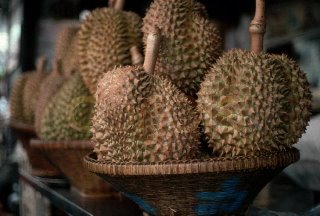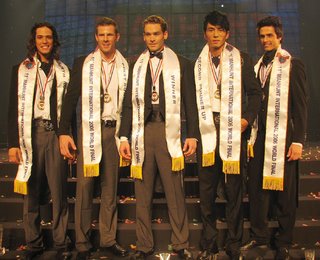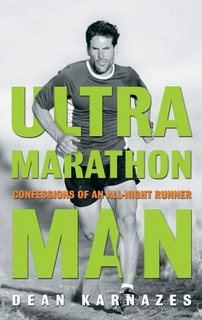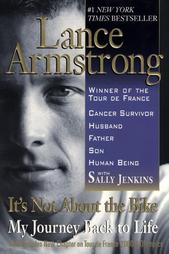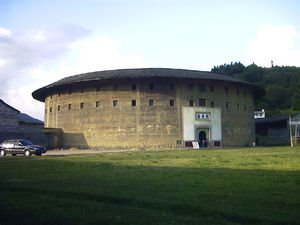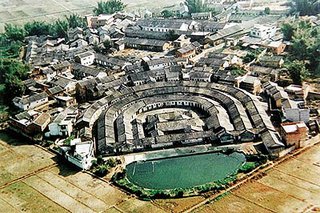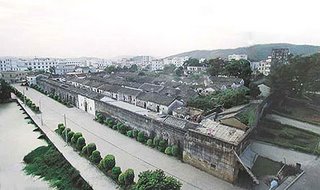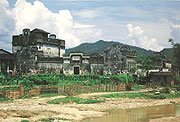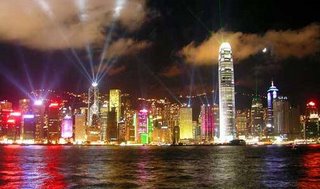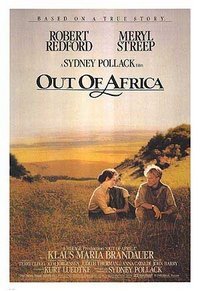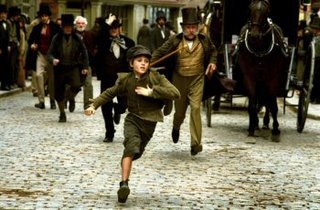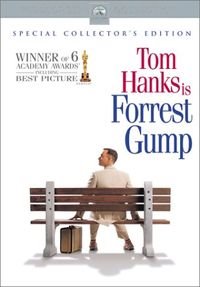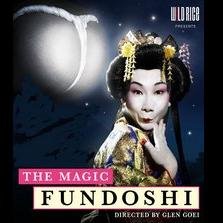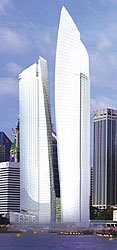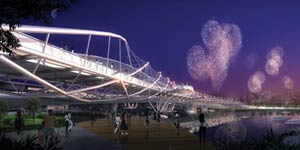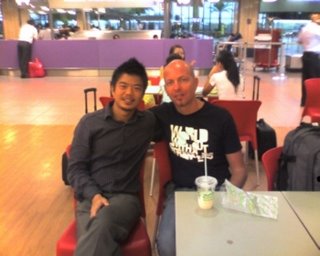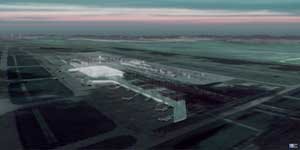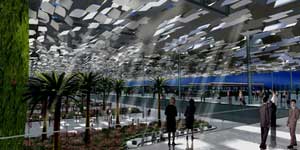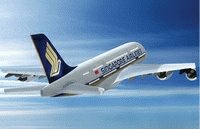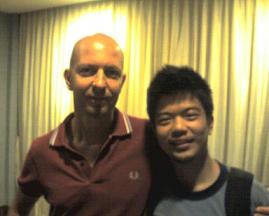
Yesterday, I arranged the meeting between Kenichi and Ricko in the City Hall MRT Station at 7pm as Kenichi might want to go to Paris. So at least Ricko could be there to lead Kenichi given his zero background in
Francais language. We went down to Esplanade @ Bay and we explained to Ricko that this Esplanade's rooftops is shaped like a pair of spikey durians or ugly eggshaped roof-top. We signed the word Esplanade in a way we use "E" letter and placed both hands on our eyes to show the shape of the houseflies' eyes. At that time, it was around 7:30pm and the night has already fallen. Ricko went to the end of the viewing rooftop to take photo of the beautiful Singapore skyline with the merlion in front of the skyline.
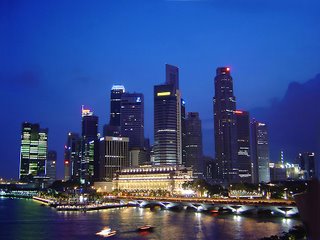
You can see the photo of Singapore skyline from the Esplanade rooftop. I explained to Ricko that by 2010, the Singapore skyline will be changed drastically and forever. Beside this present famous Singapore skyline, there will be a major development of Marina South with the inclusion of Singapore flyer which will be scheduled to be opened in 2008. See some of the photos here.
I also explain to Ricko that Singapore has already legalized the gambling and it will be the first Asian city to have Integrated Resort by 2010. Integrated resort proposed casino-based resorts in Marina South and Sentosa. The government claims that it would boost the Singapore's tourism industry which is facing intense competition from other destinations around the region, particularly from Bangkok and Hong Kong. In addition to the casinos, the IRs will have other amentities including world-class hotels, restaurants which serve international gourmets from French to Japanese, convention centres, theatres, museums, and theme parks. Currently, there are 4 major bidders for this IRs at Marina South. The winner of this most-coveted IR will be known in June 2006. See the examples of IRs put forward by IRs bidders.



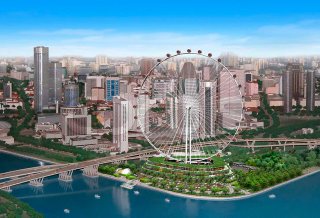
Artist Illustration Released Of Planned Giant Ferris Wheel In Singapore. An artist's impression of the Singapore Flyer, a giant observation wheel at the Marina Bay in Singapore. The giant observation wheel, set to be an iconic visitor attaction, will be 178 meters tall with an unobstructed radial view of 45 km spanning Singapore, Malaysia and Indonesia when completed in 2008. The wheel will be built in Singapore's Marina Bay area, where the city-state also plans to build a casino. The S $240 million (116 million euros) Singapore Flyer project was said to be financed by German banks Delbrueck Bethmann Maffei (DBM) and Bayerische Hypo- und Vereinsbank AG (HVB).
--------------------------------------------------------------------------------------
SPEECH BY MINISTER FOR NATIONAL DEVELOPMENT, MR MAH BOW TAN AT THE BRIEFING ON MARINA BAY KEY DEVELOPMENTS AND BRAND LAUNCH ON 21 JULY 2005 AT 9.30AM, TOWER CLUB, 62ND FLOOR REPUBLIC PLAZAMARINA BAY: A BEACON OF CHANGE AND PROGRESS FOR SINGAPOREIntroduction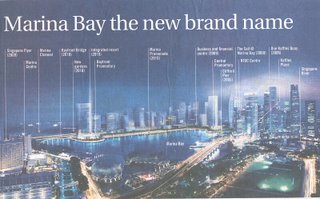
It is my pleasure to be here this morning, to celebrate the launch of the brand name for the Marina Bay area. From this vantage point in the heart of the CBD, we look with pride and anticipation at the significant developments in this area, as well as the future possibilities in the making even as we speak. Much has been achieved in the development of Marina Bay in the last five years, and many more new exciting things are being planned.
The hardware: pieces of the jigsaw falling in place
Like a gigantic jigsaw puzzle, the significant pieces are rapidly falling into place to create the picture of a distinctive waterfront city in a garden.
Our vision for Marina Bay is that of a 24/7 live-work-play environment that epitomizes the global city we envisage Singapore to be. Marina Bay is to be a place for thriving business, gracious living, and endless entertainment. It is to be a place of creativity, arts and culture, architectural excellence, world-class recreation, global commerce and modern city life.
LiveWhat has happened on the ground is most gratifying. The construction of the first landmark residential development, The Sail @ Marina Bay is well underway and the development is expected to be completed by 2009.
WorkThe NTUC Centre is fully operational while One Raffles Quay, which will provide Grade A office space, is substantially underway. Just last week, yet another big piece of the jigsaw fell into place when we awarded the Business and Financial Centre (BFC) to a consortium comprising Keppel Land, HongKong Land and Cheung Kong Holdings. We need to ensure that Singapore remains one of the most pro-business countries in the world and a gateway to opportunity throughout Asia. The development of the BFC supports this. It will cater to growing demand for prime office space in our CBD over the next 10 years and beyond.The BFC tender attracted nine bids from local as well as regional players. This signals confidence in Singapore’s economy and is a stamp of approval from developers in our plans for Marina Bay.
PlayThe Marina Bay will also be one huge playground for Singaporeans and visitors alike. In about 4 to 5 years, the Integrated Resort, the second Botanic Gardens, the promenade, and the Marina Barrage will be ready for our enjoyment and entertainment! Not far away, the Clifford Pier should also have been transformed into another activity hub.
InfrastructureThe successful development of Marina Bay is supported by state-of-the-art infrastructure. We have taken pains to provide timely and appropriate services and facilities to enable the smooth functioning of Marina Bay.
We are close to completing the first phase of the Common Services Tunnel (CST) which will provide electricity, water, cooling water and telecommunications for the entire area. Singapore is the first country in Southeast Asia to implement the CST on a comprehensive scale for Marina Bay. Tenders for the second phase of the CST and supporting infrastructure have been called.
Singapore's MRT network will also be extended to the Marina Bayfront area, with three new stations added to the Circle Line now being built. To be called Downtown Extension, it will offer seamless connections to and within the Marina Bay area.
Software: the colour and the shineMarina Bay is not only an important addition to our business and commercial scene, but also a great place for people to live and play. The entire area is designed to create living communities, nodes of life and memorable events. There are plans to create public spaces for the public to gather, and to develop lifestyle and F&B uses along the waterfront to generate activity. Marina Bay will also be a great venue for mega events that will draw people from all over. The software will not be neglected. While buildings may give shape and form, it is the people and activities that add soul to a place.
This will be an important factor in setting us apart from other cities, and was a major consideration in the development of our brand name for the area.
Facing competitionCities around the world are experiencing a new burst of energy, be they New York, London, Dubai from further afield, or Kuala Lumpur, Bangkok, Shanghai or Hong Kong nearer to home. We face increasing competition amongst many cities for the same global pool of investment, talent and jobs.
Singapore is consistently ranked as one of the most competitive nations and best places for business. We are also ranked as one of the best places to live. However, globalisation has made cities increasingly similar in what they can offer.
The key to Singapore’s success lies in our ability to distinguish ourselves from the rest, capitalizing on our strengths and uniqueness.As the Development Agency for the Marina Bay, the Urban Redevelopment Authority (URA) has moved beyond its traditional role to act as a place manager for Marina Bay. It will not only co-ordinate infrastructure development, but also will work with other agencies and stakeholders to also give Marina Bay a true sense of place. It will promote the area and attract people to visit or invest in it. To add to this effort, URA has come up with a branding exercise to help us market the area both locally and internationally.
The brandPlace branding, like product branding, is one of the means to create a differentiation that will appeal to the buyers’ emotions, and interest them to invest and to visit. Place branding goes beyond the logo and tagline. It has to define a compelling central idea and vision that will set the place apart from its competitors, while staying relevant and inspirational to the audience. The brand must also be credible and credibility is achieved through consistent actions in the product, processes and communication.
Today, I am pleased to formally launch the brand for the area: Marina Bay.
The brand was developed through research and consultation with developers, retailers, restaurant owners, entertainment companies, tourism interests and many others.
The name is not new. But what has been used informally so far has now endeared itself to all parties. “Marina Bay” has a strong connection with people. The locals and even some foreign investors are familiar with the name. URA has market tested the name internationally with professionals, investors and lay people and they have found the name to be attractive and at the same time, evokes an appealing imagery.
URA will promote Marina Bay overseas, via this new brand, which also fits well with Singapore’s international positioning as a great place to live, work and play.
The brand builds on this with a new tagline of Explore, Exchange and Entertain.
Marina Bay will be a great place to live, where people will explore the waterfront, the botanic gardens and the many cultural options available. It will provide new housing for city living.
Marina Bay will also extend our commercial district, with state of the art offices where people will exchange ideas and learning.
And Marina Bay will be an important entertainment centre, with major attractions like the Integrated Resort and the Singapore Flyer, complementing facilities like the Esplanade Theatres on the Bay.
Making it happen – a partnershipNo one party can make Marina Bay a success by itself. It requires a close collaboration by many different players to bring the place to life.
Today’s launch of the Marina Bay brand is an important milestone for us but its ultimate success lies in what we do over the next few years to promote it and develop it.
We are looking forward to this journey and showing how Marina Bay – and, indeed Singapore - is breaking new ground in the way cities are planned and developed.
Thank you.
------------------------------------------------------------------------------------
Then we went to Marina Bay to have a dinner and then I took them to Bugis Village to try durians. It was Ricko's first time to sample stinky fruit yet succulent and yellow flesh.
